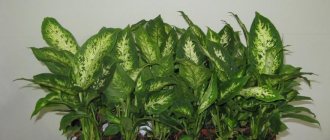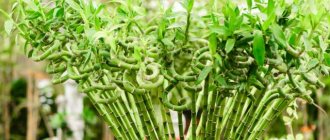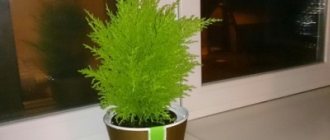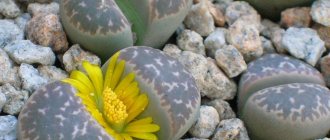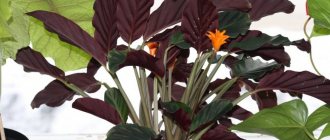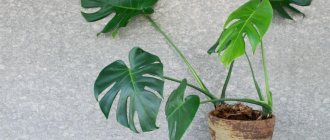Dieffenbachia is an evergreen plant with inconspicuous flowers, which are extremely rare at home. Breeders are attracted to the leaves, which are full of bright colors all year round. The juice is poisonous and has astringent properties, causing laryngeal swelling in concentrated form. It is believed that the presence of this plant in the bedroom weakens male power.
Positive properties include the ability to absorb negative energy. It is better to place the flower in the living room or kitchen, where quarrels occur more often. The released substances cleanse the air of toxins: xylene, formaldehyde, benzene and trichlorethylene. For apartments and houses located near roads, this is an indispensable assistant.
Proper care will allow Dieffenbachia to show its best side, extinguishing negative outbursts and creating an atmosphere of harmony in the family.
Features of caring for Dieffenbachia
The evergreen tropical guest has huge variegated leaves with unique patterns. Thanks to these marble inclusions, the plant is especially appreciated by lovers of decorative flowers. With proper care, Dieffenbachia can grow like a real tree, and if not trimmed in time, it will definitely hit the ceiling.
The only negative is that it is very poisonous. For many, this drawback negates all its advantages and becomes the reason for negative reviews on the Internet. But if you take precautions, there will be no harm. Moreover, the milky juice itself is toxic in it, which you still need to try very hard to get. Therefore, when growing Dieffenbachia, we follow two rules:
- We wear gloves;
- We do not allow children and cats to play with the plant.
By the way, animals miraculously try to avoid contact with this plant. Apparently they sense danger.
These were the main features of a flower, and now let’s go deeper into each of its needs.
Lighting
In the wild, the plant lives in tropical forests under the canopies of tall trees. Therefore, direct sun is destructive for Dieffenbachia . If a flower is exposed to the sun, its delicate leaves get severe burns. The optimal lighting for it is light partial shade.
Dieffenbachia also grows well in bright but diffuse lighting. It should not be placed in the shade. Lack of lighting will cause excessive elongation of the shoots and their severe weakening. With a lack of light, a flower quickly loses its decorative effect.
In winter, Dieffenbachia most often suffers from insufficient lighting. You should move it to the most illuminated southern window sill. You should not be afraid of direct sun in winter; during this period it will not harm the flower.
Temperature
The homeland of Dieffenbachia is the hot tropics, so it loves warmth very much and is afraid of sudden temperature swings. Comfortable temperatures for her are from 22 to 28 in the summer. In winter, it tolerates temperatures from 17 to 22 degrees well, but if it is below 10 °C, it can get sick and even die.
The plant enjoys being in the fresh air, but it is afraid of drafts. Therefore, we ventilate, but so that our queen does not get blown out.
In general, it is very easy to care for and grows very quickly.
Bloom
Dieffenbachia, with careful care and comfortable conditions, is capable of blooming, because it is not for nothing that it belongs to the aroid family. The buds are shaped like calla lilies and spathiphyllums: a long ear, surrounded by a light green or beige blanket, with a massive thick core.
This phenomenon is characterized by growth retardation, since all forces are spent on the release of peduncles. The lower part may become very exposed.
At home, this is very rare and most owners have never witnessed this miracle. All that remains is to admire the photo.
Watering
It is important not to deny Dieffenbachia watering. I water it with settled water about once every three days and after 20 minutes I drain the draining water from the pan. She cannot tolerate dryness. At least until the top layer of soil dries out a couple of centimeters, it still endures, and then it begins to suffer.
If the soil dries out completely, the plant will stop growing and drop its leaves.
If there is excess moisture, the roots can rot, so we also do not allow overwatering. In winter, spraying is sufficient for the tree.
Sources
- Dieffenbachia // The Plant List (https://www.theplantlist.org/1.1/browse/A/Araceae/Dieffenbachia/)
- Visyashcheva L.V., Sokolova T.A. Industrial floriculture. Textbook for technical schools // M.: Agropromizdat, 1991 – 368 p.
- Dr. Hessayon D.G. All about indoor plants // M.: Kladez-Buks, 2002 – 256 p.
- State catalog of pesticides and agrochemicals approved for use on the territory of the Russian Federation as of July 6, 2022 // Ministry of Agriculture of the Russian Federation (https://mcx.gov.ru/ministry/departments/departament-rastenievodstva-mekhanizatsii-khimizatsii -i-zashchity-rasteniy/industry-information/info-gosudarstvennaya-usluga-po-gosudarstvennoy-registratsii-pestitsidov-i-agrokhimikatov/)
Reproduction
I really like the way Dieffenbachia reproduces. If you want - with cuttings, if you want - with trunks. The last option is generally very simple: just cut the trunk into several parts and place it in water with activated carbon, and soon it will begin to take root. Or you can immediately plant it in the ground and cover it with film on top, making a greenhouse.
There is another way - propagation by seeds, but this is very painstaking work and for real professionals.
Dieffenbachia does not reproduce from a leaf, like, say, a ficus. By the way, I already wrote an article about ficus propagation. But there are also similarities between them. Both plants can be grown by air layering. The principle is the same, I also wrote about this in the article.
The soil
Dieffenbachia grows well in soil with an acidity of 5.6-5.8. The soil for Dieffenbachia should be well permeable to water and air. This will allow oxygen to penetrate to the roots of the flower, and water will flow away without stagnating in the soil.
A universal substrate for decorative deciduous plants with the addition of peat is suitable..
When using such an earthen mixture, it is recommended to add charcoal to its composition.
When making soil for Dieffenbachia yourself, you can use the following compositions:
- 4 parts leaf soil, 2 parts peat, 2 parts dry moss, 1 part sand and 0.5 parts charcoal;
- 4 parts leaf soil, 1 part sand, peat and humus, 0.5 parts charcoal.
Similar articles:
- Propagation of Dieffenbachia by cuttings and seeds
- Causes of yellowing of Dieffenbachia leaves
Growth and transplantation
I have already mentioned the frantic growth of Dieffenbachia. I would also like to draw your attention to the fact that, unlike other plants, it grows even in winter and does not stop growing, it only slows down a little.
Thanks to this pace, my 20-centimeter appendage grew to almost 2 meters in 12 months! But this is rather my fault - I missed the moment to form the crown and trim the top. Otherwise, it would have grown into a lush bush rather than an upright palm tree.
It is better to always take a pot for Dieffenbachia with a reserve, about 2 cm larger than the previous one. She loves space very much, and her roots quickly fill the space.
If the plant has grown to 1 meter or more, we transplant it to a new place by transferring it along with a lump of soil on the roots. In a new spacious pot we pour a layer of drainage from broken bricks, shards or foam chips.
We select nutritious, loose soil, which consists of deciduous soil, compost, sand, coal or sawdust. Although, it seems to me that it is easier to buy universal primer in a store.
I also want to draw attention to the container in which we will plant Dieffenbachia. A plastic flowerpot is not the best option for her. We give preference to natural materials such as clay, bamboo, ceramics.
Trimming
In addition to the fact that you often have to cut off damaged leaves of a flower, it is also important to pinch the top in time. As a rule, a bare lower trunk and a lot of leaves at the top indicate that it’s time to take action.
Things to remember when starting pruning:
- We work only with gloves (you can even wear glasses to protect your eyes from the caustic juice);
- We treat sharp tools with alcohol (after trimming too);
- Wipe the cut area dry with a napkin and sprinkle with activated carbon.
How much to trim? There are no strict rules here, the main thing is to leave at least 10 centimeters of the stem. Even a bare stem quickly recovers after pruning and can quickly increase the mass of leaves.
Answers to readers' questions
Lifespan
Dieffenbachia can live for a long time until the long stem becomes bare and it loses its beauty. Then you need to trim it and grow a new flower or root the top. Bushy Dieffenbachias can generally live for many years with good care.
Is Dieffenbachia poisonous?
The plant is very poisonous. Its milky sap, if it comes into contact with the skin, can cause burns and a severe allergic reaction. If it gets on the mucous membrane it causes swelling.
Why can’t you keep Dieffenbachia at home or is it possible?
Dieffenbachia can and should be kept at home. You just need to take precautions, in particular keep it out of reach of children.
Studies have shown that Dieffenbachia has the ability to purify the air from formaldehyde and other toxins.
Why do the leaves turn yellow and dry?
For Dieffenbachia, the natural process is to gradually lose the lower leaves. If leaves on other parts of the plant turn yellow and dry, this may indicate that the temperature is too low or there are drafts.
Why don't new leaves grow?
Perhaps Diffinbachia begins to bloom, then new leaves grow much more slowly. You need to trim the inflorescence unless you are not interested in flowering.
How does the plant overwinter?
In autumn and winter, Dieffenbachia rests, so watering is reduced and fertilizing is stopped. In winter, you need to make sure that the root system does not freeze, this can destroy the flower. The temperature should not be below +18 degrees.
Top dressing
We feed with mineral and organic fertilizers with a predominance of nitrogen at least once a month. The feeding period is from late spring to September. If we have just transplanted a flower, it is better to let it adapt for two or three weeks without feeding.
If you regularly stimulate Dieffenbachia with fertilizers, there is a chance that it will bloom. But in general, with proper care, the plant feels great even without feeding.
The leaves have turned yellow - we are looking for the cause
Dieffenbachia can also get sick, like all plants. Most often, the cause should be sought in care. For example, if we find that its leaves are turning yellow, the reason may be the following:
- she is cold or standing in a draft;
- hard water;
- much water;
- a lot of spraying;
- direct sunlight;
- not enough sun;
- requires an increase in living space (the pot is cramped).
For a clear overview of transplanting Dieffenbachia, selecting a pot and replanting time, I suggest watching a short video:
Possible problems
Pests and diseases
The most common pests that settle on domestic Dieffenbachia are: scale insects, thrips, spider mites, aphids and mealybugs. You can try to get rid of them mechanically: thoroughly wash the foliage and stem of the plant with a sponge moistened in a soap solution. In this case, the soap solution must be washed off the bush with running water. If there are a lot of pests, then the plant should be treated with a solution of Karbofos or Actellik (15 drops per 1 liter of water).
It happens that Dieffenbachia develops bacteriosis. It manifests itself in the formation of watery areas on the foliage that have clear boundaries. This disease is bacterial, and a diseased bush cannot be cured. This perennial can also suffer from root rot. First, the part of the bush located underground rots, and then the foliage and shoots. The plant may die. After areas with a grayish coating appear on it, it is necessary to immediately take the necessary measures: reducing watering, replacing the soil mixture, spraying with a solution of a systemic fungicidal preparation.
Dieffenbachia turns yellow
Often, inexperienced gardeners are faced with the problem of yellowing foliage. As a rule, this occurs as a result of violations of the rules of crop care, as this leads to weakening of the plant and an increase in the likelihood of it being damaged by pests or diseases.
Most often, the foliage of Dieffenbachia turns yellow if the bush is exposed to a draft or the room is too cold. Yellowing can also be caused by a lack of nutrients in the soil or watering with high hardness water. The foliage also turns yellow if the plant becomes infected with root rot.
Why do Dieffenbachia leaves turn yellow? Causes of yellowing leaves.
What causes it to dry out?
Dieffenbachia may also begin to dry out. If the lower leaf plates turn yellow, dry out and fly off, then there is no need to worry, since this process is considered natural. If the trunk is significantly exposed, it is necessary to carry out rejuvenation; for this, cuttings are cut and rooted. However, if young leaf blades dry out, this is most likely due to exposure to cold, draft, or the bush is regularly watered too sparingly.
Dieffenbachia withers
If the foliage has lost its turgor, and the soil mixture in the pot is dry, this means that watering is carried out very rarely. But if the soil mixture is wet and the foliage is limp, then most likely this is due to root rot. If rot is detected from the roots, the entire substrate must be carefully removed. Cut out rotted areas using a very sharp, sterilized tool. Sprinkle all cut areas with ground cinnamon or charcoal powder. Next, the bush is planted in fresh soil mixture. In the future, it needs to be watered more rarely and less abundantly.
